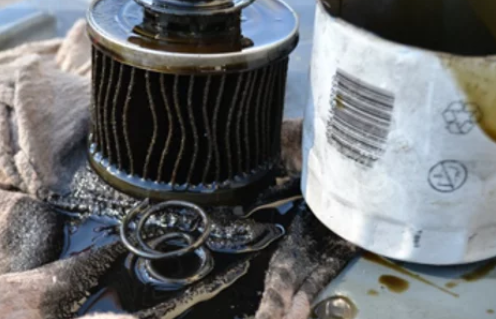Inspect inside your oil filter
The FAA has stringent maintenance requirements for aircraft engines, which are under high use and stress. The same reasoning can be applied to your competition or street cars. When maintaining an engine used in competition or constant hard-driving, it is good to inspect the inside of the oil filter to search for fragments of bearing materials or other debris. The proper way to open the oil filter is to use a specialized cutting tool. There are a few companies that offer this tool. We carefully used a cut off wheel for our video. This is not recommended due to the possibility of metal shavings and foreign particles entering the oil filter, which would deliver a meaningless lab oil analysis.
Once the oil filter is opened, pour the oil into a clean drain pan where you can inspect the oil for metallic shavings. The oil may have a pearly luster appearance due to tiny metallic particles that are made of iron, aluminum, or titanium, depending your engine internals. This is considered normal since particles are usually from cylinder walls, pistons, and rings. When disassembling the pieces of the filter to access the paper filter media, check to see if there are big metal flakes, shavings, or debris trapped in the pleats. This gives you the chance to find out your engine’s condition.
Noble M12 Engine Oil Analysis
Engine oil analysis can provide valuable information to owners of vehicles if the proper information is obtained. Important questions to ask about the oil in your car:
Is the correct engine oil being used?
Are certain additives and base oil properties being diminished quickly?
Are there external contaminants in the oil that should not be present (e.g. dust, water)?
Are there internal contaminants in the oil (e.g. fuel, glycol, soot)?
Any signs of abnormal wear in the engine?
Is the type of wear typical of an initial failure?
Is the cause of the wear isolated to a known type of failure?
Which oil tests to use:
Viscosity – film thickness between mechanical surfaces moving relative to one another.
Base Number – as the oil ages the base number will trend downwards, but a sudden change could be an indicator of increased blow-by containments due to severe running conditions or using the wrong oil.
Particle Count – contamination exposure can be harmful to the engine’s oil, but it’s expected during the operation of the vehicle. The results can tell you the ineffectiveness of an intake air filter or oil filter.
Water – abnormal amounts of water.
Ferrous Density – wear debris at abnormal levels that will lead to engine failure.
Fourier Transform Infrared (FTIR) Spectrocopy – provides information on the oil’s health. Also, what contaminants are present like glycol, fuel, nitrates, oxides, soot, and sulfates.
Elemental Spectroscopy – similar to FTIR, but it focuses on the oil as the elemental concentrations increase or decrease. This will tell if increased contamination level or a reduction in additives in the oil is associated to a specific wear pattern. Other possible tests include acid number, blotter spot, flash point, and fuel dilution.
Note: The most important oil sample is the break-in new engine oil. You can possibly see the highest wear of metal in the oil. If you see levels about 50% higher than your break-in oil, then you have an engine problem.






